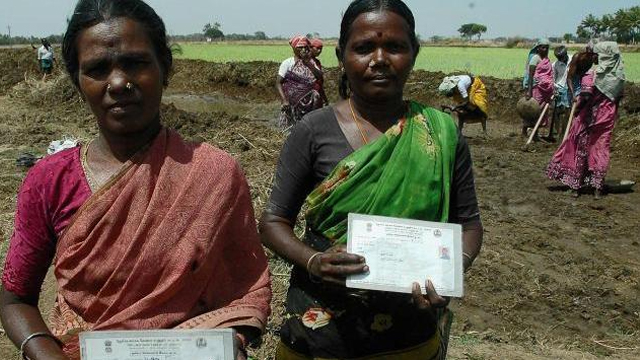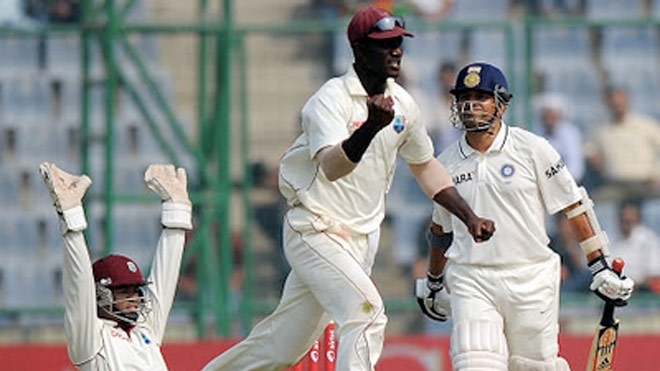To substantiate its claims of “Congress ka haath, aam aadmi ke saath”, the government has been extremely vocal of its prized initiative-the National Rural Employment Guarantee Scheme(NREGS) launched in 2006.
To substantiate its claims of “Congress ka haath, aam aadmi ke saath”, the government has been extremely vocal of its prized initiative-the National Rural Employment Guarantee Scheme(NREGS) launched in 2006. The scheme finds mention in the party’s manifestoes, and nearly all leaders–including Sonia Gandhi and Prime Minister Manmohan Singh–have underscored its importance in their poll campaigns. Rahul Gandhi, with his much publicised act of “shramdaan” in rural Rajasthan and Uttar Pradesh, cemented the image of NREGS as a poverty eradicating, employment generating initiative of the UPA last year. It has since been effectively used as a major poll plank to support the party’s “development” oriented stance. The Bharat Nirman campaign initiated by the Congress also highlights its positive impact.
So far, so good.
Yet, claims by many (including Rahul Gandhi), that “the NREGS has ensured enforcement of minimum levels of wages across the country” is arguable. Serious loopholes have been found in the implementation mechanism of the scheme, and massive corruption has resulted in the diversion of funds from the intended “target group” to the middle order “beneficiaries”. Many rural poor have not been issued job cards, yet their names are present in the files, and vice versa. There is a massive demand for work, but lack of implementation of the scheme has not quelled the rising problem of unemployment, special post the economic meltdown that has affected the small-scale industries. A large chunk of labourers in India are migrants from rural parts of India, and affected by the slump have returned to their native villages only to find there is no work available to suit their skills. Herein lies the problem with the implementation of the NREGS.
Faced with such problems, a substantial populace of jobless youth is getting increasingly frustrated and hopeless with the system as whole. For instance, in villages near the Firozabad town of Uttar Pradesh, most young men are engaged as bonded labour in already over manned farms. Disguised unemployment is on the rise, due to the systematic weaknesses in the scheme. A report on the NREGS released by the Comptroller and Auditor General of India in 2008 found many discrepancies in the implementation of the scheme at the state and district level. In West Bengal, for example, CAG reported that funds had been used in seven villages for at least 20 projects, which astonishingly did not exist.
The issuance of job cards is another grey area. Most people are aware of the NREGS, but a common complaint in a large part of rural India is that “yahan to laagu nahi hua hai.”(It’s is not implemented here.) The problem of migrant labourers, and their non inclusion in the scheme in poor states like Bihar and Orissa also goes against the intention of the scheme. Further, an NREGS job card is to be given to all households in need of work, but reality is different. In the village of Chauma near Aligarh in Uttar Pradesh, the actual target group of unemployed poor youth alleges that most of the influential members of their village community use their clout to get extra cards for their families, thus eating into their share. The “100 days employment guarantee” also raises questions. First, are 100 days a year enough to eradicate poverty for below poverty line households? Secondly, even if it is assumed that all BPL households get job cards and employment, the reality is that the number of days of employment are neither reported or registered officially, and do not balance the demand for work. Such problems are plenty, owing to the corruption at the district level in almost all states.
The NREGS is undoubtedly a path-breaking endeavour on part of the government to counter poverty, but sadly there is a clear lack of will in implementation at the grassroot level in many states. Due to this, the benefits of the scheme–like other flagship programs–has not reached the least advantaged of the village communities. Till these aspects are not resolved, resources would continue to be squandered, the poor would remain poor and crime and frustration would rise.
A few suggestions: One, instead of kutcha work which is the main work undertaken through the NREGS(clearing of forests, digging up wells and ponds etc), more of pucca construction work should be included. Monsoons are dreaded in many households of rural India, since they devastate their homes(usually made of hay, wood and mud). And more often than not, they cannot afford the repairs every season. If the NREGS could include repairs of ravaged homes in its implementation, problems of many would be solved simultaneously.
Second, NREGS in its present form involves pure labour work. A scheme of such large magnitude would thus only result in creating a massive workforce of unskilled labour, a waste of human resources. In Uttar Pradesh, a significant chunk of the rural youth, who have completed their schooling and some who have even graduated from the local polytechnic, have expressed reservations to work meted out to them in the NREGS. “It is a waste of their skills and education, and the NREGS should be altered to address their needs too,” is the common refrain among the youth.
Lastly, a programme which offers upgradation of skills and training should also be included in the NREGS. This would create a skilled workforce, and would also give them a freedom of “choice”, sorely missing in most government schemes(excluding the Rashtriya Swasthya Bima Yojna, which gives beneficiaries an option to select a hospital of their choice for free treatment).
In a nation like India, where poverty is rampant, schemes like the NREGS need to be strengthened urgently. For people who cannot afford even two square meals, living on less than a dollar a day, schemes like the NREGS give hope. And when they do not get results, it not only crushes their hope, but also their trust in the government and politics. This disillusionment, is not healthy for “the world’s largest democracy”, and must be quelled through increasing the efficacy of welfare schemes.
*views expressed are personal





